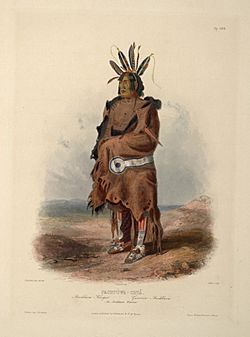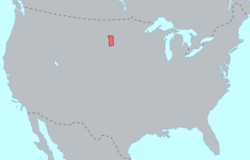Arikara facts for kids
| Regions with significant populations | |
|---|---|
| North Dakota | |
| Languages | |
| English, Arikara | |
| Religion | |
| Christianity, Native American Church | |
| Related ethnic groups | |
| Caddo, Kitsai, Pawnee and Wichita |
The Arikara people, also known as Sahnish, are a Native American group living in North Dakota. Today, they are part of the Three Affiliated Tribes on the Fort Berthold Reservation.
Contents
What Does "Arikara" Mean?
The Arikara are sometimes called the Arikaree or the Ree. Their name might mean "horns." This comes from an old custom of wearing two upright bones in their hair. The name could also mean "elk people" or "corn eaters."
Arikara Language
The Arikara language is part of the Caddoan language family. It is similar to the Pawnee language, but speakers of one cannot easily understand the other. Today, only a few elders still speak Arikara fluently. One of the last fluent speakers, Maude Starr, passed away in 2010. She was a certified teacher who helped with Arikara language programs.
Arikara History and Lifestyle
For many centuries, the Arikara were a semi-nomadic group. They lived on the Great Plains of the United States for hundreds of years. During seasons when they stayed in one place, they lived in earth lodges. When they traveled or hunted bison, they used portable tipis as temporary homes.
The Arikara were mainly farmers. Their women grew different kinds of corn, also called maize. Corn was so important to their society that they called it "Mother Corn."
Dogs as Helpers
Traditionally, an Arikara family owned many dogs, sometimes 30 to 40. Dogs were used for hunting and as guards. Most importantly, they helped with transportation before horses became common on the Plains. Many Plains tribes used a device called a travois.
A travois had two long poles attached to a dog's shoulders with a harness. The ends of the poles dragged behind the dog. A frame in the middle held loads that could weigh over 60 pounds. Women used dog-pulled travois to carry firewood or even babies. They also used them to transport meat during hunts. A single dog could pull a quarter of a bison.
Challenges and New Homes
In the late 1700s, many Arikara people died from smallpox epidemics. This greatly reduced their population and changed their way of life. Because their numbers were smaller, the Arikara began to live closer to the Mandan and Hidatsa tribes. This helped them protect each other.
They slowly moved from what is now Nebraska and South Dakota into North Dakota. This move was due to pressure from other tribes, especially the Sioux, and from European-American settlers. Later, during the Black Hills War in 1876, some Arikara served as scouts for Lt. Col. George Armstrong Custer. They helped him during the Little Bighorn Campaign.
Today, the Arikara, Mandan, and Hidatsa tribes live together. They are settled on the Fort Berthold Indian Reservation in North Dakota.
Images for kids
See also
 In Spanish: Arikara para niños
In Spanish: Arikara para niños










